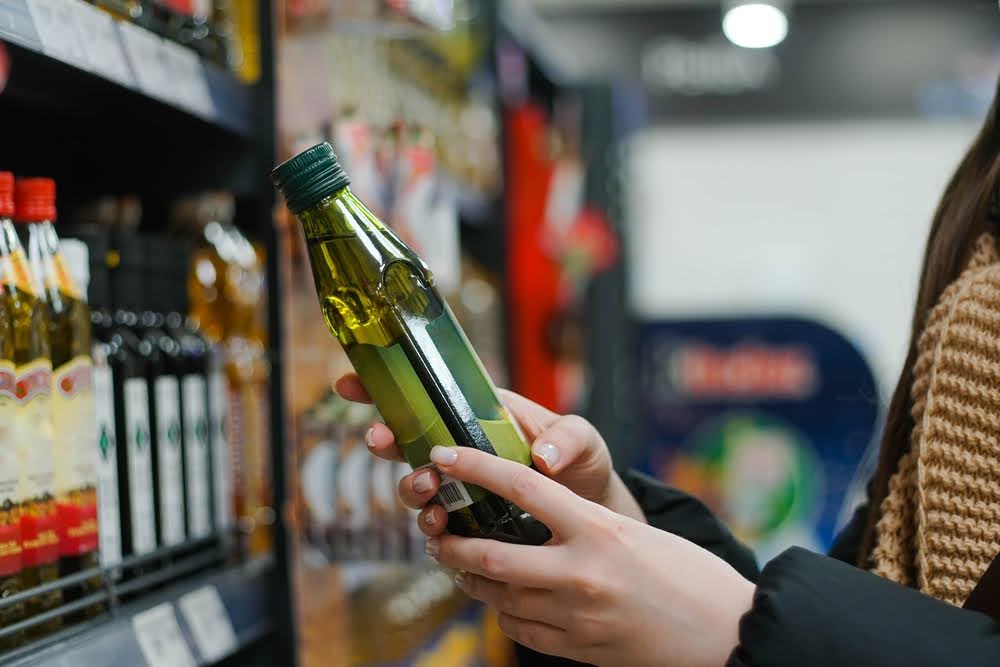Olive oil, a staple of the Mediterranean diet, is revered not only for its versatility in cooking but also for its numerous health benefits. Rich in monounsaturated fats, antioxidants, and anti-inflammatory properties, olive oil is associated with lowering the risk of heart diseases, improving cholesterol levels, and even aiding in weight management.
However, the rising popularity of olive oil has led to a surge in the production and distribution of counterfeit products. These fake olive oils, often labeled as high-quality extra virgin, fail to provide the health benefits they claim, and in some cases, might even be harmful due to the substandard or improper processing methods used.
The issue of adulterated olive oil in the market is a growing concern among health-conscious consumers, nutritionists, and culinary experts. Being able to identify genuine from fake olive oil is crucial not just for the sake of enjoying its rich, distinctive flavor but also for ensuring that one receives its well-documented health advantages.
The Journey of Authentic, Quality Olive Oil
The production of authentic olive oil is a meticulous process that starts with the careful selection and harvesting of olives. Olives must be picked at the peak of ripeness to ensure the oil’s quality and flavor profile. Once harvested, the olives are quickly transported to the mill to prevent spoilage and degradation.
Here, they are cleaned and prepared for extraction, with any leaves, stems, and debris removed. This initial step is crucial as it influences the oil’s final taste and purity, setting the stage for high-quality production that counterfeiters often overlook when producing fake olive oil.
In the milling phase, olives are crushed into a paste using large stainless steel rollers. This crushing is done carefully to ensure that the olives are not overheated, which can compromise the oil’s flavor and nutritional content.
The paste is then subjected to malaxation, a slow mixing process that helps the tiny oil droplets in the paste to coalesce and separate from the water and solid materials. Malaxation must be performed under specific conditions of temperature and duration to maximize yield while maintaining the oil’s chemical integrity.
Finally, the olive paste undergoes extraction through centrifugation. In this stage, the paste is spun at high speeds to separate the oil from the water and solids. The resulting oil is then decanted and stored in stainless steel containers at a controlled temperature to prevent oxidation.
This careful handling is essential to preserve the oil’s health-promoting properties, including its antioxidants and vitamins, which are often compromised in fake olive oil products due to negligent processing or the addition of cheaper oils.
This detailed and controlled process highlights the authenticity and quality of true olive oil, distinguishing it starkly from the counterfeit products flooding the market. By understanding these steps, consumers can become more informed and vigilant, helping to ensure that they purchase genuine, high-quality olive oil.

How to Identify Authentic Olive Oil and Avoid Fake Olive Oil Scam
To distinguish genuine olive oil from those compromised by the olive oil scam, it’s essential to understand the sensory attributes that characterize high-quality oil.
Freshness
One of the primary indicators of premium olive oil is its freshness. Genuine olive oil should smell like fresh olives, with possible hints of grass, fruit, or floral notes depending on the olive variety.
Any scent that resembles mold, vinegar, or rancidity suggests degradation and potential adulteration, common markers in lower-quality or fake oils.
Taste
The taste of olive oil is another vital quality marker. Authentic high-quality olive oil will have a noticeable fruitiness and can also exhibit flavors like bitterness and pungency. These tastes are natural characteristics of olive oil, derived from the phenolic compounds that offer health benefits such as anti-inflammatory properties.
A mild bitter sensation is typically a sign of fresh, healthy olives, while a peppery kick in the throat should be brief but noticeable, indicating the presence of antioxidants. Olive oils lacking these complex flavors or leaving an unpleasant aftertaste often signal the olive oil scam, where the product might be diluted with cheaper, refined oils.
Texture
Finally, the texture of olive oil can provide clues about its purity and quality. Genuine olive oil should feel smooth and not greasy. In contrast, a waxy or sticky texture might indicate the presence of lower-quality oils or fats added to the product.
Color
Consumers should also be aware of the color, which can vary from green to golden depending on the type of olives used and their ripeness at harvest. However, color alone should not be the sole criterion for quality, as it can be misleading and easily manipulated with additives.
Understanding these sensory aspects and being able to evaluate them can help consumers avoid falling victim to the olive oil scam, ensuring they reap all the health and culinary benefits of true extra virgin olive oil.
Evaluating Olive Oil Brands for Authenticity
When selecting olive oil, the brand can often be a good indicator of quality, but it requires careful scrutiny due to the prevalence of mislabeled products. Understanding which olive oil brands consistently deliver authentic, high-quality oil can help consumers make better purchasing decisions and avoid falling for fraudulent products.
- First, it’s vital to look for certifications on the label. Reputable olive oil brands will often have one or more certifications from recognized authorities, such as the International Olive Council or regional certifying bodies, which validate the oil’s quality and authenticity. These certifications ensure that the oil meets strict standards regarding production and quality.
- Another crucial aspect is the origin of the oil. Some of the best olive oils come from regions renowned for olive oil production, such as Tuscany in Italy, Andalusia in Spain, and certain areas in Greece and Portugal. These regions have a long-standing reputation for producing high-quality olive oils with distinctive flavors. Authentic brands will clearly state the oil’s geographic origin, offering traceability and assurance of quality.
- Lastly, consumers should be wary of olive oil brands that offer their products at significantly lower prices. While price isn’t always a direct indicator of quality, exceptionally low-priced olive oils may suggest that the product has been diluted with cheaper oils or is not truly extra virgin. Researching brand reviews and participating in olive oil tastings can also provide insights into the quality and reliability of different brands.
By carefully evaluating olive oil brands and their attributes, consumers can steer clear of inferior products and ensure they are purchasing genuine, high-quality olive oil.

Top Authentic Olive Oil Brands to Trust
Discovering genuine, high-quality olive oil can elevate your cooking and health. Here’s a curated list of some of the best authentic olive oils that deliver not only on taste but also on integrity and quality:
- Bariani Olive Oil: Known for its traditional methods, this olive oil is stone crushed, cold-pressed, decanted, and unfiltered. Bariani is committed to producing a raw, real oil highly recommended by Weston Price for its purity and natural production process
- California Olive Ranch: An award-winning brand known for its 100% Californian olives, this oil is stored in tinted glass bottles to protect its quality from light and heat, ensuring the oil remains fresh and flavorful.
- Kirkland Organic: A popular choice among consumers, this olive oil is certified organic by the USDA and made from the first cold pressing of olives. Reviews often highlight its delicious flavor that truly tastes like real olives. An excellent choice available on Amazon, where it enjoys a high rating, with 73% of reviewers giving it 5 stars.
- Cobram Estate: This Australian brand is celebrated as the most awarded in the country. Cobram Estate has earned accolades for its dedication to quality and flavor, even winning the title of Best Olive Oil in 2016.
- Corto EVOO: Praised for its freshness, Corto olive oil is marketed as “TRULY 100% extra-virgin”. The brand takes pride in early harvest techniques that capture the peak flavor and freshness of the olives, distinguishing it from others that may harvest later in the season.
- McEvoy Ranch Organic: From its estate-grown Italian olive varieties, this certified organic oil is a testament to quality and care. The oil features a vibrant grass-green color, with aromas of freshly cut grass and green apple, packaged in a dark green bottle with a built-in spout for convenience.
- Ottavio: This high-quality extra virgin olive oil from Italy offers a vibrant bouquet and a fresh, spicy flavor profile. However, it is packaged in a plastic bottle, which might affect long-term quality preservation.
- Bertolli Organic Extra Virgin Olive Oil: After overcoming earlier misconceptions about its quality, Bertolli has proven its excellence by exceeding international standards and achieving multiple awards at prestigious olive oil competitions. This makes it a reliable choice for organic olive oil consumers.
- Chacewater California Extra Virgin Olive Oil: Renowned for its quality, this olive oil was the winner of the Best Olive Oil 2015 contest, continuing to uphold its reputation for superior quality and flavor.
- Ellora Extra Virgin Olive Oil: Sourced from Crete, this 100% pure Cretan extra virgin olive oil is certified by EU standards, ensuring both its origin and high quality are well-documented and authentic.
Understanding Olive Oil Labels and Certifications
Navigating olive oil labels and certifications is crucial for distinguishing high-quality products from substandard ones. This knowledge can empower consumers to make informed decisions and avoid falling prey to misleading marketing.
When examining olive oil labels, the first thing to look for is the designation of “extra virgin.” This term is legally regulated and denotes the highest quality of olive oil, characterized by superior flavor and aroma with no chemical or sensory defects. The acidity level, which should be no more than 0.8%, is another critical indicator of the oil’s quality and freshness.
Certifications can also provide an additional layer of trust. Look for seals from reputable organizations such as the North American Olive Oil Association (NAOOA) or the European Union’s Protected Designation of Origin (PDO) and Protected Geographical Indication (PGI). These certifications indicate that the olive oil meets stringent production and quality standards and often involves third-party testing.
Moreover, traceability is another aspect crucial for authenticity. Premium olive oil brands will often provide information about the oil’s specific harvest date, the variety of olives used, and the production region. This transparency allows consumers to verify the oil’s source and assures them of the product’s quality and freshness.
Understanding these elements on olive oil labels not only helps in avoiding inferior products but also ensures that consumers are choosing oils that offer the full health benefits and flavors that genuine olive oil is celebrated for.
The Impact of Fake Olive Oil on Health and the Industry
The presence of fake olive oil in the market has significant repercussions not only for consumer health but also for the olive oil industry as a whole. Understanding these impacts can help underscore the importance of vigilance and informed purchasing when it comes to olive oil.
Health Implications
Consuming fake olive oil can lead to the intake of oils that have been adulterated with cheaper, potentially harmful substances like canola or sunflower oil, which do not possess the same health benefits as true olive oil.
These substitutions can include trans fats or processed fats that have been treated with chemicals or high heat, altering their nutritional profile and potentially leading to health issues over time.
Moreover, the antioxidants and anti-inflammatory properties of genuine olive oil are largely absent in counterfeit products, depriving consumers of the significant health benefits olive oil is known for.
Industry Effects
For producers of genuine, high-quality olive oil, the proliferation of counterfeit products damages the market’s integrity and consumer trust. This makes it challenging for authentic producers to compete, especially as fake oils often undercut genuine products with significantly lower prices.
The economic impact extends to regions known for their olive oil production, where farming and production are critical economic activities. Ensuring the authenticity of olive oil not only supports these local economies but also protects cultural heritage associated with olive oil production.
By promoting awareness and education about the authenticity of olive oil, both consumers and regulatory bodies can take steps to mitigate these negative effects. Ensuring that only high-quality, genuine olive oil reaches consumers helps maintain public health standards and supports the sustainability of the olive oil industry globally.
My Personal RX on Dietary Health and the Power of Authentic Olive Oil
As a doctor, I cannot overemphasize the importance of selecting high-quality olive oil for your daily diet. Genuine olive oil offers remarkable benefits for your heart and brain health, thanks to its rich content of monounsaturated fats and antioxidants. Integrating authentic olive oil into your meals can significantly enhance your overall well-being, while ensuring you avoid the potential hazards associated with counterfeit products.
Here are my personal tips for making the most out of your olive oil selection and usage:
- Choose Certified Extra Virgin Olive Oil: Always opt for oils that are certified extra virgin to ensure you’re getting the highest quality and purity. This label guarantees that the oil has been extracted without chemicals and under temperatures that preserve its essential nutrients.
- Check for Harvest Date: Purchase olive oil with a clearly marked harvest date. Freshness is key, so look for oils that have been harvested within the last year to maximize the health benefits.
- Integrate Omega-3 Fish Oil in Your Diet: For holistic heart health and cognitive function, consider complementing your diet with Omega-3 Fish Oil. This supplement works synergistically with olive oil to enhance your cardiovascular health and mental clarity.
- Experiment with Recipes from my Superfoods Cookbook: Enhance your culinary experience by integrating olive oil into wholesome recipes from my Superfoods Cookbook. This guide offers fun and enjoyable ways to include superfoods like high-quality olive oil in your diet.
- Store Properly: Keep your olive oil in a cool, dark place away from heat sources like the stove or oven. Proper storage helps maintain its flavor and health properties.
- Use for Dressing, Not Cooking: To preserve its health benefits, use olive oil primarily for dressings or add it to dishes after cooking. High heat can break down its beneficial compounds.
- Taste Test Before Buying: If possible, taste the olive oil before purchasing to ensure it has a fresh, clean taste without any bitterness or rancidity, which can indicate oxidation.
By following these tips, you can fully enjoy the health benefits of olive oil and ensure that what you consume is not only delicious but also genuinely beneficial for your health.
Sources:
- Higher Olive Oil Intake Associated with Lower Risk of CVD Mortality – American College of Cardiology. (2022, January 10). American College of Cardiology. https://www.acc.org/About-ACC/Press-Releases/2022/01/10/18/46/Higher-Olive-Oil-Intake-Associated-with-Lower-Risk-of-CVD-Mortality
- Olive oil may lower heart disease risk. (2022, June 2). www.heart.org. https://www.heart.org/en/news/2020/03/05/olive-oil-may-lower-heart-disease-risk
- Mapes, S. (2023, February 1). How is Olive Oil Made: A Step-by-step Guide. EXAU Olive Oil. https://exauoliveoil.com/blogs/olive-oil/how-extra-virgin-olive-oil-is-made
- Saffitz, C. (2018, January 26). How to buy olive oil: A beginner’s guide. Bon Appétit. https://www.bonappetit.com/story/how-to-buy-olive-oil-beginners-guide




















